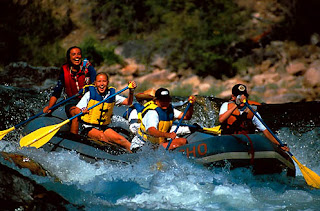- Water extraction
- Irrigation of agriculture
- Urban areas
- Generating Electricity
- Hydroelectric power
- Recreational activities
- Boating, swimming, etc.
Case study: The Colorado River
Located in the southwestern United States and northwestern Mexico, the Colorado River is a 2,330-kilometers long. The river is the primary source of water for a region that receives little annual rainfall. The Colorado River system, including the Colorado River, its tributaries , and the lands that these waters drain, is called the Colorado River basin. It drains a total area of 637,000 square kilometers. Today nearly 17 million people depend on the Colorado's waters.
This article from the Smithsonian Institute discusses how the Colorado River, once one of America's largest, has been drastically reduced by dams for hydroelectric power, irrigation for agriculture and climate change. Is this the direction in which the world is heading?
Colorado River Runs Dry - Smithsonian Institute
 |
| The Colorado River spans across 7 states and part of Mexico. |
Colorado River Runs Dry - Smithsonian Institute
1. Water extraction
- Irrigation of Agriculture
- Colorado River
- Each year, an estimated 18,000 million cubic meters of water is extracted from the Colorado River
- States that are extracting water are: California, Arizona, New Mexico, Colorado, Utah, Nevada and Wyoming. Mexico also extracts the rivers water.
- 90% of extracted water on the Colorado River is used for agriculture
- Since 1922, each State on the Colorado River is a part of the Colorado River Compact In which each state is allocated a certain amount of water it is allowed to extract per year
- Though this is a good way of limiting the water withdrawn from the river, an editorial in the New York Times explains that the water extracted is based on measurements in 1922. Since then, water levels have dropped, and in order to keep up to date with the river flow, states need to intensify water conservation efforts.
- The Colorado River's Future - The New York Times
- The Colorado River evidently a very important source of accessible, drinkable water
- Pros
- An importance source of agricultural irrigation
- Cons
- Over extraction can lead to water scarcity
- LEDCs sometimes have inefficient irrigation systems, which involve:
- silt entering the system
- over-watering
- water escaping
- salinisation of water and fields
- run-off of pesticides and chemical fertilisers resulting in polluted water
- Urban usage
- Colorado River
- 10% of extracted water is left for urban uses
- Used for municipal drinking water
- Pros
- An importance source of drinking water in cities
- Cons
- The Colorado River contains large amounts of solids (mostly salt) in the water
- Salinity increases downstream primarily due to agriculture, evaporation, and the leeching of salts from soils - As a result, expensive desalination plants must be built
- In LEDCs, water supplies are often very polluted and the government lacks the funds to upgrade water treatment facilities
Numerous dams were built on the Colorado and its tributaries during the twentieth century. The purpose of these dams was primarily to generate hydro electricity, control floods, and provide recreational opportunities. They also store water during wet times for use during the dry months and, in some cases, during dry years.
2. Hydro Dams
- Colorado River
- Many Hydro dams have been built on the Colorado River including: The Glen Canyon Dam, Hoover Dam, Parker Dam and Davis Dam
- The basin dams are able to store more than 86 billion cubic meters of water along with producing an estimated 10 million mega-watt hours annually
- Pros
- Storage of water on the river
- Produces power
- Controls flooding and provides an area for recreational activities
- Renewable energy source
- Cons
- Hydroelectric power production require flooding of entire valleys and scenic areas.
- Disrupts natural seasonal changes in he river, and ecosystems can be destroyed.
- Ends flooding that help to clean out the silt in rivers, causing them to clog
- Dams are expensive
- Due to drought dams may become useless, or produce much less power than originally planned.
 |
| The Glen Canyon Dam |
3. Recreational Activities
References:
- Colorado River
- The Colorado River is a place for a wide range or recreational activities like:
- Boating
- Canoeing
- Fishing
- White water rafting
- There are also many on-land activities that rely on the river like:
- Hiking
- Biking
- Camping
- Horseback riding
- Pros
- These activities are vital to the local economy. They stimulate tourism and without the river many small towns would vanish.
- Cons
- Large amounts of tourism or recreation can disturb the local areas and wildlife
 |
| White Water Rafters on the Colorado River |
For another case study on how water is used at the regional scale, read about the Karakum Canal in Turkmenistan in the Planet Geography Textbook.
Planet Geography Textbook - Stephen Codrington
